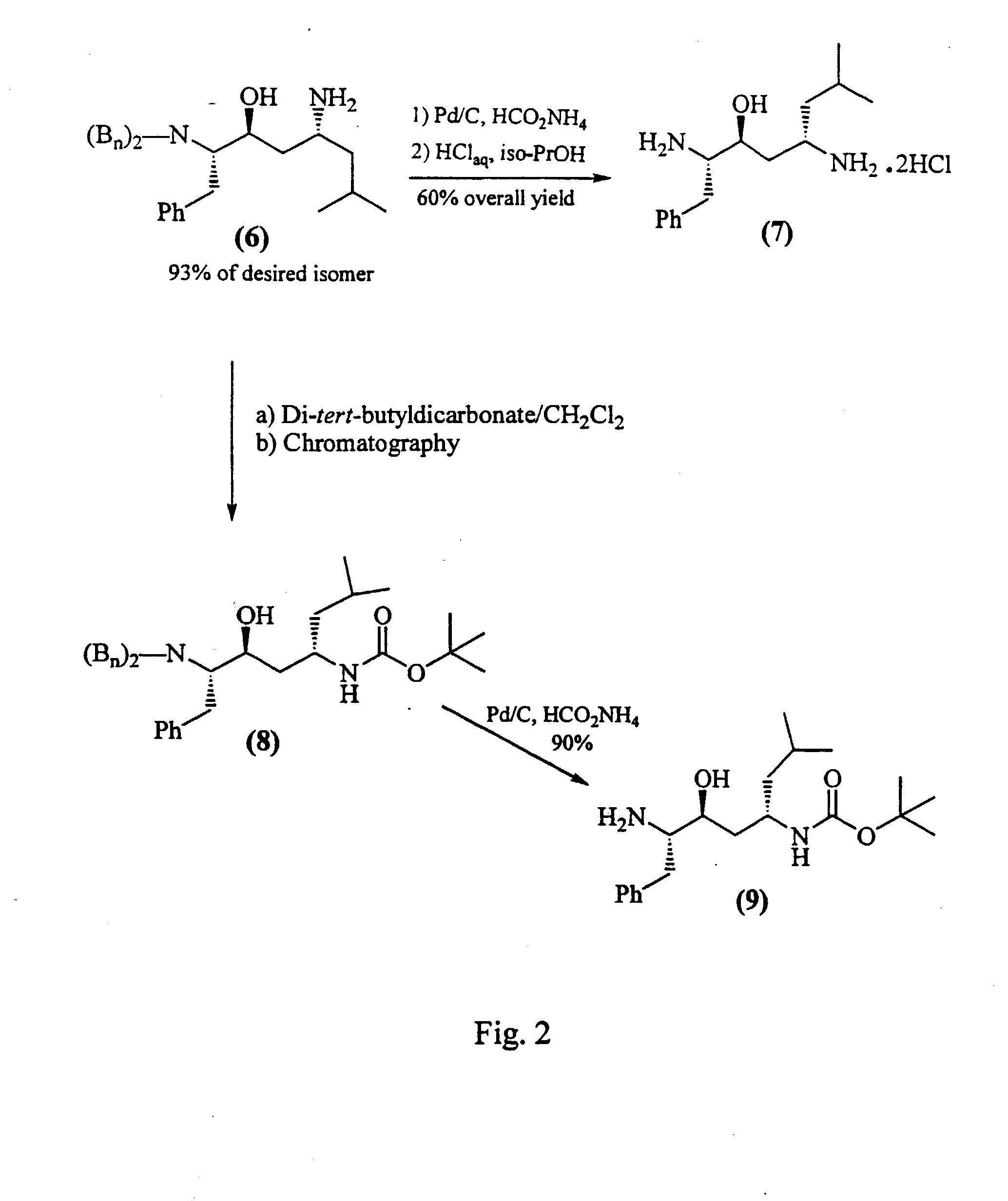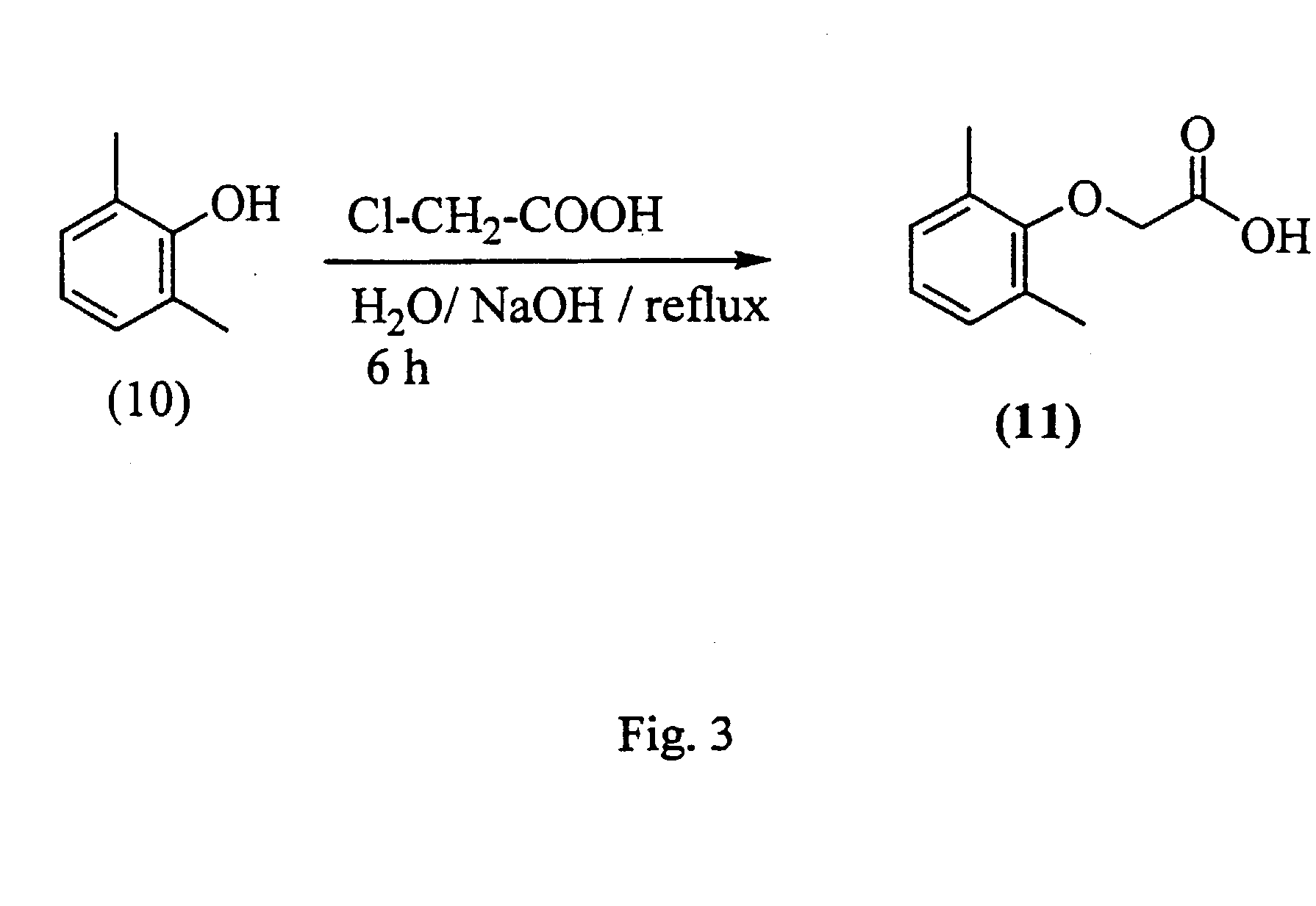Aspartic protease inhibitors
- Summary
- Abstract
- Description
- Claims
- Application Information
AI Technical Summary
Benefits of technology
Problems solved by technology
Method used
Image
Examples
synthesis examples
[0096] The following protocols were used in the synthesis of the compounds of the present invention. Proton nuclear magnetic resonance (1H NMR) spectra were recorded on a Varian XL-200 or VXR-500S MHz spectrometer. 1H NMR spectral data are reported in δ ppm scale relative to TMS. High resolution mass spectra were recorded on a VG70-250 and FAB mass spectra on a VG ZAB-2F (Manchester, England) mass spectrometer. Flash chromatography was performed on silica gel (230-400 mesh, E. Merck). HPLC analysis were carried out using a Hewlett Packard 1050 chromatograph using an analytical column YMC-Pack ODS-AQ is (C18) (250×4.6 mm, S-5, 120 Å) reverse phase column and methanol / water (0.05% trifluoroacetic acid) mixtures as mobile phase (gradient 50-100% of methanol during 30 min.). Thin-layer chromatography was performed on silica gel F-254 plates (0.25; 0.50@1 mm Whatman) and visualized using sulfuric acid or chlorine or ninhidrin / TDM (4,4′-tetramethyldiaminodiphenylethane) and UV methods. TL...
example 1
[0097] This example illustrates the synthesis of (L)-N,N-dibenzylphenylalanine benzyl ester, compound (2) of FIG. 1. To a homogeneous solution of L-phenylalanine (75 g, 0.45 moles), K2CO3 (200 g, 1.45 moles), and water (300 mL) was added benzyl chloride (182 g, 1.44 moles). The solution was heated at reflux for 16 h (prolonged reflux is necessary to destroy excess BnCl). Heptane (200 mL) and water (150 mL) were added to the cooled reaction mixture. The organics were separated and washed twice with 150 mL of water / methanol (2 / 1 v / v). The organics were concentrated in vacuo to afford 190 g of a lite yellow oil which was >90% pure by HPLC. An analytical sample was prepared by flash chromatography (10% EtOAc / hexanes): R1 0.65 (25% Et)Ac / hexanes); 1H NMR (CDCl3) δ 7.5-7.0 (m, 20H), 5.3 (d, 1H, J=13.5 Hz), 5.2 (d, 1H, J=13.5 Hz), 4.0 (d, 2H, J=15 Hz), 3.8 (t, 2H, J=8.4 Hz), 3.6 (d, 2H, J=15 Hz), 3.2 (dd, 1H, J=8.4, 14.4 Hz).
example 2
[0098] This example illustrates the synthesis of (4S)-4-dibenzylamino-3-oxo-5-phenyl-pentanonitrile, compound (3) of FIG. 1. The crude ester 4 (190 g, 90% pure, 390 mmol) was dissolved in THF (510 mL) and cooled to −45° C. under nitrogen. To a separate flask was charged 95% sodium amide (38.4 g, 940 mmol) under nitrogen followed by THF (425 mL). The slurry was cooled to −45° C. and CH3CN (52 mL, 1.0 mol) was added over 15 minutes. The anion solution was added to the ester solution over 15 minutes and was then stirred at −45° C. for 2h. The reaction was quenched with 900 mL of 25% w / v aqueous citric acid. The organics were separated and washed with 900 mL of 20% w / v brine. The organics were filtered and concentrated in vacuo. The residue was crystallized from 500 mL of ethanol (denatured with toluene to afford 112 g (78%, 67% for two steps) of a white solid: mp 84-85° C.; R, 0.55 (25% EtOAc / hexanes); 1H NMR (CDCl3) δ 7.3 (m, 15H), 3.9 (d, 1H, J=19.5 Hz), 3.8 (d, 2H, J=4.0, 13.5 Hz), ...
PUM
| Property | Measurement | Unit |
|---|---|---|
| Molar density | aaaaa | aaaaa |
| Molar density | aaaaa | aaaaa |
| Molar density | aaaaa | aaaaa |
Abstract
Description
Claims
Application Information
 Login to View More
Login to View More - R&D
- Intellectual Property
- Life Sciences
- Materials
- Tech Scout
- Unparalleled Data Quality
- Higher Quality Content
- 60% Fewer Hallucinations
Browse by: Latest US Patents, China's latest patents, Technical Efficacy Thesaurus, Application Domain, Technology Topic, Popular Technical Reports.
© 2025 PatSnap. All rights reserved.Legal|Privacy policy|Modern Slavery Act Transparency Statement|Sitemap|About US| Contact US: help@patsnap.com



